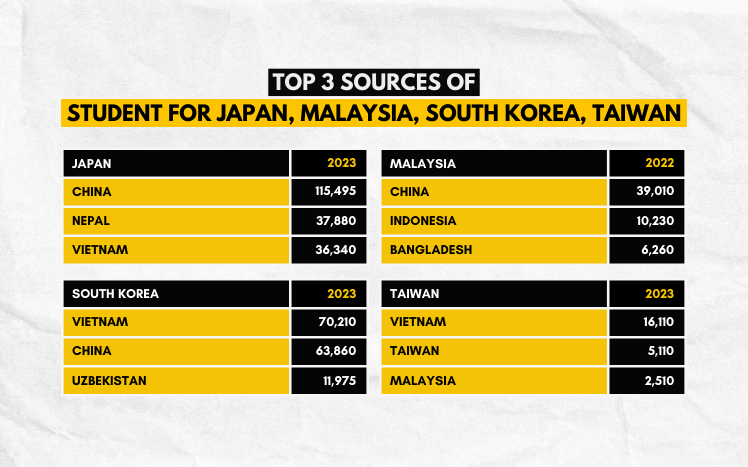Japan, Malaysia, Taiwan, and South Korea have all set ambitious new international enrolment targets. These are:
- Japan: 400,000 by 2033
- Malaysia: 250,000 by 2025
- Taiwan: 320,000 by 2030
- South Korea: 300,000 by 2027
To date, this is the progress the four destinations have made:
- Japan: 279,275 international enrolments as of May 2023 (+21% over 2022).
- Malaysia: Between 115,000 and 170,000 enrolments currently (estimates vary). Malaysia tends to report application volumes publicly rather than enrolment volumes. Looking at this measure, Malaysian institutions received 58,285 applications in 2023, a 14% increase over 2022 following a 28% increase the previous year. Asia contributed the most growth – especially East Asia (+22% over 2022).
- Taiwan: 116,040 in 2023, representing a 90% recovery from foreign enrolment losses in the pandemic. Just over 6 in 10 (61%) of Taiwan’s international students are from “New Southbound Policy” (NSP) countries: Brunei Darussalam, Burma, Cambodia, Indonesia, Laos, Malaysia, Philippines, Singapore, Thailand, and Vietnam, Bangladesh, Bhutan, India, Nepal, Pakistan, and Sri Lanka, Australia, and New Zealand.
- South Korea: 205,170 as of March 2023 (+23% over 2022).
South Korea is thus approaching the volume of Japan’s current foreign enrolment as it adheres to a strategy known as the Study Korea 300K Project. That strategy aims to position South Korea as one of the world’s top 10 study abroad destinations by 2027.
The following table shows top markets for each of the four Asian destinations. It also demonstrates the large number of Vietnamese students opting to study in Asia as opposed to the West. For example, South Korea enrols more Vietnamese students than do Canada (17,175) and the US (21,900) combined.


